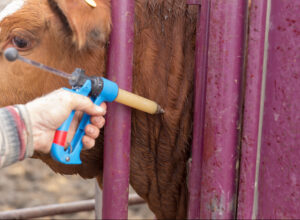The Cost Benefit of Using Vaccines in Beef Cattle
Remarque : cette page web n’est actuellement disponible qu’en anglais.

Vaccination is a proven tool for disease prevention. Vaccination recommendations vary by region and by farm as the environment, production, and management practices can increase or decrease the amount of risk cattle are exposed to. Disease exposure occurs in numerous places including community pastures, fence line contact with neighbouring cattle, auction markets, and breeding cattle, such as bulls, purchased from other herds. However, vaccinating breeding females for reproductive disease and calves for respiratory disease are recommended practices across Canada. A vaccination program should be developed in consultation with a veterinarian who can determine which ones are necessary for your area.
In western Canada, one in ten producers surveyed are not vaccinating their cows for infectious bovine rhinotracheitis (IBR) and bovine viral diarrhea virus (BVD) (Waldner et al., 2019) and more than a quarter of producers do not vaccinate cows for other reproductive diseases (Beef Cattle Research Council, 2019). One third of Ontario producers do not vaccinate their cows for BVD and far fewer vaccinate for other reproductive diseases. In Atlantic Canada, 27% of producers reported not administering general vaccinations. This leaves herds vulnerable.
Why Vaccinate for BVD?
When a cow is infected with BVD in early pregnancy, the offspring may be born persistently infected (PI). PI animals are generally considered to be the primary source for transmission of the virus.
BVD infection can lead to poor conception rates and both BVD and IBR can cause abortions in cattle. Blood tests show exposure to these diseases is common in unvaccinated herds. There is evidence from several experimental trials that these vaccines are effective. When multiple studies are analyzed, the outcome shows that on average there is an 85% decrease in fetal infection, 45% decrease in abortions and a 5% increase in pregnancy rates in BVD-vaccinated herds. Field studies in western Canada have shown improvement in pregnancy rates and a decrease in abortion rates for vaccinated cows compared to unvaccinated cows on community pastures.
In the U.S., total annual losses have been estimated at $20 million for every million calves when modeling for low-virulent BVD strains and $57 million when modeling for a high-virulent BVD strain (Houe, 1999). If we take Canada’s breeding herd at 3.9 million beef cows, estimated BVD losses here would be in the range of $78 and $220 million (Clarke, 2014).
The Cost Benefit of BVD Vaccinations tool allows producers to input their herd size, expected price, animal weights, cost of vaccine and labour to see the potential savings from vaccinating cattle for BVD specifically from changes in reproductive performance caused by abortions.
Why Vaccinate for BRD?
Bovine respiratory disease (BRD) is one of the costliest health issues facing the beef industry today. While a lot of research on BRD has been focused at the feedlot stage, the disease is also the most common cause of death for nursing calves older than three weeks. BRD can impact any producer, including those who retain ownership of their calves to background, feed, or finish cattle.
Research by USDA ARS Meat Animal Research Center that tracked the annual incidence of BRD in pre-weaned calves over a 20-year period found that the annual incidence varied from a low of 3% to a high of 24% with an overall annual average of 11%. On average, the mortality rate of calves suffering from pre-weaning BRD was 13%.
Once calves are affected by BRD, there are both immediate and long-lasting effects on performance. Studies have shown that calves challenged by BRD could weigh up to 36 pounds less at weaning than their healthy herd mates (Wittum and Perino, 1995).
Vaccinating for BRD can help producers manage the disease, enhance animal welfare and reduce the need for antibiotics whether they are backgrounding or finishing a few cattle of their own, retaining ownership of their calves for a longer period of time, or simply wanting to create a reputation for supplying quality calves. While it may seem like the main beneficiary of BRD vaccines are feedlots purchasing vaccinated calves, other segments benefit as well.
The Cost-Benefit of Feeding BRD Vaccinated Calves tool allows producers to input their own numbers of feeder cattle purchased (or retained), feeder and fed price, weight, cost of gain, days on feed and treatment cost to calculate and compare the expense of feeding calves that have not been vaccinated for BRD. The tool itemizes costs including death loss, treatment costs, and performance losses due to lower average daily gain and lower quality grades, that arise from feeding calves that were not vaccinated for BRD. This calculator can help determine the potential premium that could be paid for BRD-vaccinated calves, assuming the vaccines are effective.
- References:
- Clarke, R. (2014). BVDv eradication still a North American pipe dream. Western Canadian Association of Bovine Practitioners. Available at: http://www.canadiancattlemen.ca/2014/12/31/bvdv-eradication-still-a-north-american-pipe-dream/
- Houe, H. (1999). Epidemiological features and economical importance of bovine virus diarrhoea virus (BVDV) infections. Veterinary Microbiology 64(2):89-107.
- Waldner, C.L., Parker, S., and Campbell, J.R. (2019). Vaccine usage in western Canadian cow-calf herds. Canadian Veterinary Journal 60(4):414-422
- Wittum, T.E. and Perino, L.J. (1995). Passive immune status at postpartum hour 24 and long-term health and performance of calves. American Journal of Veterinary Research. Volume 56(9):1149–1154.
Click here to subscribe to the BCRC Blog and receive email notifications when new content is posted.
The sharing or reprinting of BCRC Blog articles is welcome and encouraged. Please provide acknowledgement to the Beef Cattle Research Council, list the website address, www.BeefResearch.ca, and let us know you chose to share the article by emailing us at info@beefresearch.ca.
We welcome your questions, comments and suggestions. Contact us directly or generate public discussion by posting your thoughts below.